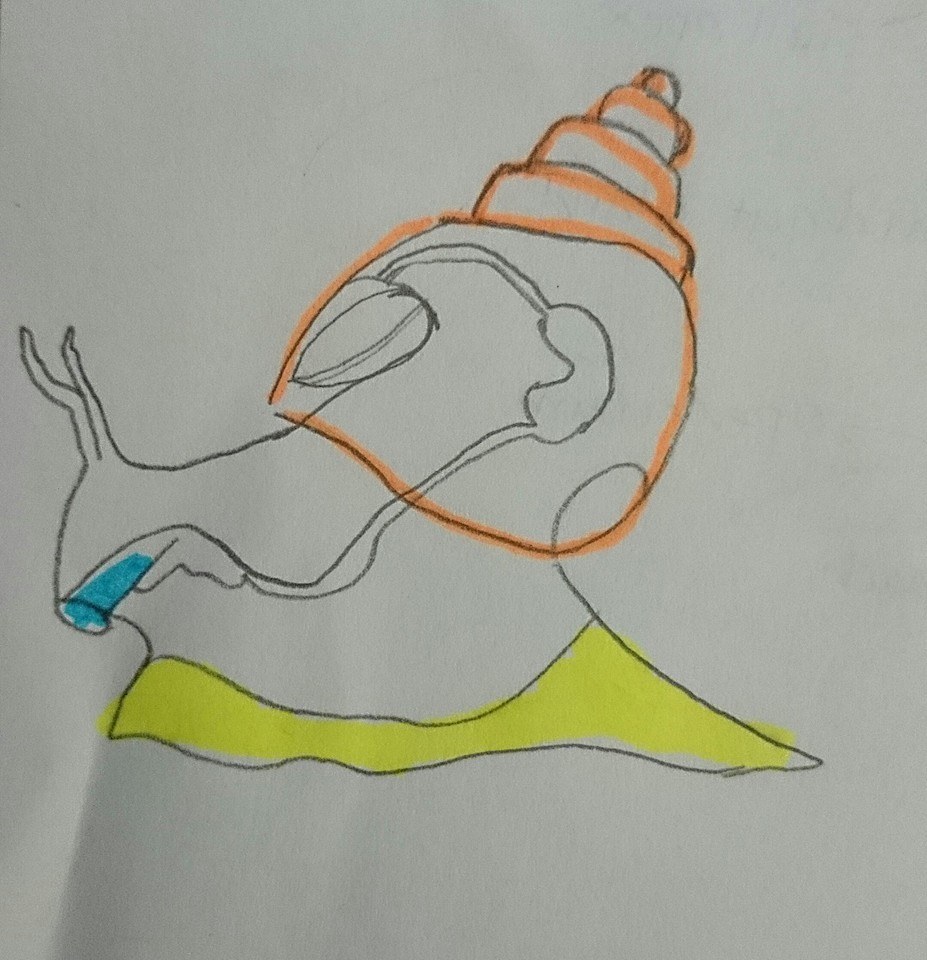

Drawing adapted from showing the foot in yellow, shell in orange and mouth in blue
The gastropod Turbo undulatus posses various observable adaptations that has led to its present ecology and life style. These include the prominent foot, radula, operculum, tentacles, shell, gills and mouth (Collin, 1995).
The body of Turbo undulatus consists of the head with of a terminal mouth, tentacles, eyes, a visceral mass largely made up of gonad and digestive system and a large creeping sole (Beechey, 2012).
The operculum plays an important function in the biology of turbo undulatus. It acts as a trap door to seal the opening of the shell after the animal is drawn inside. It is necessary for protection from potential predators i n times of danger (Collin, 1995; Kuiter, 2003).
The foot is large and fleshy. Muscle contractions in the foot enable the gastropod to perform a vital process, locomotion. Muscle contracts in a series of waves along the surface of the foot. Locomotion is further enhanced by mucus secretions at the foot which herald the adaptive process, gliding (Collin, 1995). The foot enables the animal to carry out a variety of functions, these include crawl, burrow, swim and righting the animal when upturned (Beechey, 2012).
Shell is indicative of the habitat of the snail (Collin, 1995). In Turbo undulatus, its shell is coiled, bulbous and in the shape of turban (Kuiter, 2003). It is generally composed of an outer organic layer termed periistracum,
and an inner calcified layers of calcium carbonate embedded in an organic matrix (Wilbur and Daleuddin, 1983; Watabe, 1988). The function of the shell is to cover the visceral mass and provide a cavity into which the head-foot can be retracted (Beechey, 2012). The shell is laid down one below the other around a central axis termed the collumella. The curve traced in space is an equiangular (logarithmic) spiral as growth proceeds (Raup, 1961). This indicates that turbo undulatus does not change its shape as it grows (Illert, 1983).
Aperture is the outermost of the growth rings deposited in succession outwardly from the apical protoconch(Beechey, 2012). It is suggested that there is more functions associated with the aperture than any other structure of the shell (Linsley, 1978). it provides the exit through which the head foot protrudes on contact with a substrate. It also is the point where the animal withdraws and the water from the mantle cavity passes in and out from it (Beechey, 2012).
Mantle is responsible for secreting the shell. The uncalcified, proteinaceous outer layer, peristracum is one of the layers secreted by the histochemical differentiated regions of outer mantle epithelium and underlying calcium gland cells (Beechey, 2012). The layers underneath the peristracum compose of crystalline calcium carbonate in a matrix of glycoprotein (Currey and Taylor 1974; Weiner and Hood. 1975).
Gastropods are unique to the animal kingdom in that they are asymmetrical. The anus and kidney openings are anterior and discharges over the head.
Torsion is the process in which the long nerve connectives are twisted and crossed into a figure of eight, and the intestine is twisted on itself and loops back into the visceral mass. This arrangement of organ system is secondarily derived during development as the larval gastropod is bilaterally symmetrical. The reason for the embryological rotation may be due to the contraction of differentially developed larval retractor muscles (Crofts, 1955).
The radula is another very important trait adapted for specialist grazers. This mouth part has formed the herbivorous life strategy of Turbo undulatus. Herbivores use this structure to rasp and cut algae from rocks.In some other species (carnivorous cone shells), the radula is modified to form a barbed harpoon which they use to inject a powerful toxin into their unsuspecting prey. In the spined murexes, the radula is used for drilling holes in the shells of their prey (Collin, 1995).
|